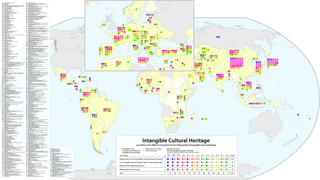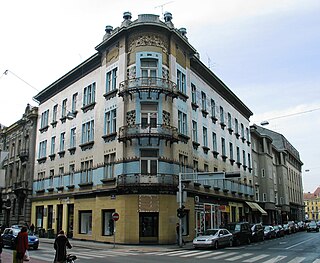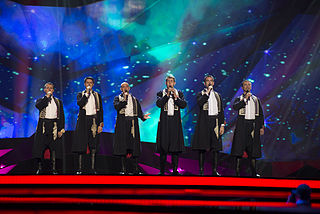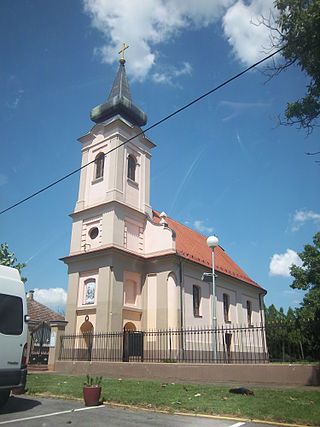Related Research Articles

Sinj is a town in the continental part of Split-Dalmatia County, Croatia. As of the 2021 census, the population was 23 500 people, of which 10 800 inhabited its urban core.

Klapa music is a form of traditional a cappella singing with origins in Dalmatia, Croatia. The word klapa translates as "a group of friends" and traces its roots to littoral church singing. The motifs in general celebrate love, wine (grapes), country (homeland) and sea. Main elements of the music are harmony and melody, with rhythm very rarely being very important. In 2012 klapa was inscribed in UNESCO Intangible Cultural Heritage of Humanity.

Zagreb Cathedral, located at Kaptol, Zagreb, is a Roman Catholic cathedral-church. It is the second tallest building in Croatia and also the most monumental sacral building in Gothic style southeast of the Alps. It is dedicated to the Assumption of Mary and to kings Saint Stephen and Saint Ladislaus. The cathedral is typically Gothic, as is its sacristy, which is of great architectural value. Its prominent spires are considered to be landmarks as they are visible from most parts of the city. One of its two spires was damaged in the 2020 Zagreb earthquake.

Zagorski štrukli or štruklji is a popular traditional Croatian dish served in households across Hrvatsko Zagorje and Zagreb regions in the north of the country, composed of dough and various types of filling which can be either boiled or baked. It is closely related to štruklji, a traditional Slovene dish.

UNESCO established its Lists of Intangible Cultural Heritage with the aim of ensuring better protection of important intangible cultural heritages worldwide and the awareness of their significance. This list is published by the Intergovernmental Committee for the Safeguarding of Intangible Cultural Heritage, the members of which are elected by State Parties meeting in a General Assembly. Through a compendium of the different oral and intangible treasures of humankind worldwide, the programme aims to draw attention to the importance of safeguarding intangible heritage, which UNESCO has identified as an essential component and as a repository of cultural diversity and of creative expression.

The Kallina House is a historic residential building in Zagreb, Croatia. The house is located in the city centre on the corner of Masarykova and Gundulićeva streets and is regarded as "one of the finest examples of Secessionist-style street architecture in Zagreb."

The Old City Hall is a complex of three adjacent buildings located in the Gradec neighbourhood in Zagreb, Croatia. The three buildings were joined in the late 19th century and since then, the complex has served as the place where all sessions of the city assembly are held.

Ojkanje is a tradition of polyphonic folk singing in Croatia characteristic for the regions of the Dalmatian hinterland, Velebit, Lika, Kordun, and Karlovac. As described in The Harvard Dictionary of Music: "The ojkanje is a particular style of singing melisma with a sharp and prolonged shaking of the voice on the syllables oj or hoj." According to experts, ojkanje is a remnant of pre-Slavic Illyrian singing from the area of ancient Dalmatia.
The natural and cultural heritage of Croatia comprises sites, monuments, goods and species of particular importance to the Republic of Croatia which are protected by national law. The Croatian constitution states that the protection of natural and cultural heritage, as well as their use needs to be regulated according to the constitution and laws of the Republic of Croatia.
The Register of Protected Natural Values of the Republic of Croatia has been created according to the Nature Protection Act in 2005. The register is being administered by the Administration for Nature Protection within the Croatian Ministry of Culture. The register serves as a reference database and unique official data source about protected areas in Croatia. The data in this register is public with the exception of special cases of confidentiality regarding the position of certain protected natural goods. The Nature Protection Act stipulates nine categories of protected areas.

Za križen is a night procession that happens every Maundy Thursday on the island of Hvar, Croatia. The event has centuries of tradition and is included in the UNESCO Intangible Cultural Heritage Lists.
The national symbols of Croatia are insignia, icons, or cultural expressions that are emblematic, representative, or otherwise characteristic of the Republic of Croatia, Croatian people, or the Croatian culture. They are being implemented within the country and abroad as a form of representation for the nation's statehood or its unique cultural aspects.

Klapa s Mora was a music ensemble that represented Croatia in the Eurovision Song Contest 2013 in Malmö with the song "Mižerja". It is a "super klapa" ensemble that includes six male klapa singers from five existing klapa groups in Croatia.
The Spring Procession of Queens is a yearly spring ritual performed in the village of Gorjani located in the Slavonia region of Croatia.
The Inter-City Intangible Cultural Cooperation Network (ICCN) is the only international organization of local governments and cultural organizations that aim to safeguard the world’s Intangible Cultural Heritage. The ICCN has been working to explore creative and effective policies for the safeguarding of local Intangible Cultural Heritage and its inseparable relation to sustainable local development. Furthermore, we aim to make cultural peace based on mutual understanding formed through intercultural dialogue.

The Kaptol manors form a series of 25 manors along the Kaptol Street in Zagreb, Croatia that were used to house canons and other officials of the Archdiocese of Zagreb. The manors were built at various times between the Middle Ages and the 19th century. Most of those preserved date from the Baroque period, while those in the best condition are mostly from the 19th century. The manors were designed as large town houses surrounded by gardens. Each has its own history and peculiarities. The most important are those which were inhabited by prominent canons.

Church of the Nativity of Saint John the Baptist in Ostrovo is Serbian Orthodox church in eastern Croatia dedicated to the Nativity of Saint John the Baptist. The church was constructed between 1747 and 1752. Before the current building was constructed there was a wooden church at the same site at least since the 1733 when it was reported in a historical document. This older church was dedicated to Pentecost. The current church was blessed by Parteniy Pavlovich on 18 June 1752. Over the years church changed its iconostasis on three occasions. The building was reconstructed in 1899, 1934, 1984 and 2005. The last reconstruction followed after the damage that occurred during the Croatian War of Independence. Prior to reconstruction, the building was included in the list of preventively protected heritage of the Register of Cultural Goods of Croatia where it stayed until 2007.
Villa Kallina is a historic country house in Zagreb, Croatia built by Vjekoslav Bastl as the family residence for the wealthy industrialist Josip Kallina's son Gustav.
References
- ↑ Zakon o zaštiti i očuvanju kulturnih dobara
- ↑ Članak 2. Hrvatski sabor ili narod neposredno, samostalno, u skladu s Ustavom i zakonom, odlučuje: o očuvanju prirodnog i kulturnog bogatstva i korištenju njime
- ↑ Croatian Ministry of Culture. Lista zaštićenih kulturnih dobara.
- ↑ UNESCO Intangible Heritage Lists
- ↑ "Annual carnival bell ringers’ pageant from the Kastav area", on ich.unesco.org.
- ↑ "Gingerbread craft from Northern Croatia", on ich.unesco.org.
- ↑ "Ojkanje singing", on ich.unesco.org.
- ↑ "Lacemaking in Croatia", on ich.unesco.org.
- ↑ "Procession Za Krizen (‘following the cross’) on the island of Hvar", on ich.unesco.org.
- ↑ "Sinjska Alka, a knights’ tournament in Sinj", on ich.unesco.org.
- ↑ "Spring procession of Ljelje/Kraljice (queens) from Gorjani", on ich.unesco.org.
- ↑ "Festivity of Saint Blaise, the patron of Dubrovnik", on ich.unesco.org.
- ↑ "Traditional manufacturing of children’s wooden toys in Hrvatsko Zagorje", on ich.unesco.org.
- ↑ "Two-part singing and playing in the Istrian scale", on ich.unesco.org.
- ↑ "Bećarac singing and playing from Eastern Croatia", on ich.unesco.org.
- ↑ "Nijemo Kolo, silent circle dance of the Dalmatian hinterland", on ich.unesco.org.
- ↑ "Klapa multipart singing of Dalmatia, southern Croatia", on ich.unesco.org.
- ↑ "Mediterranean diet", on ich.unesco.org.
- ↑ Intergovernmental committee for the safeguarding of the intangible cultural heritage. Nomination for inscription on the Representative List in 2009 , on unesco.org (page displaced)